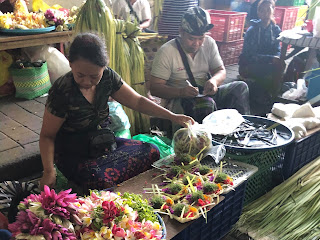Bali Offerings
I've been practicing Vipassana meditation for five years. I started it to escape my horrific anxiety and panic attacks. In 3 guided sessions, it worked like a charm. I got rid of my panic attacks and learned to control my anxiety. And more. I learned to know myself. I also tried yoga. But this post is not about my experience with meditation and yoga. It is about peace.
I have no community for my practice and I do not feel the need for one, as I am a loner. Few people are aware that I have these preoccupations. I live in a European country, one that is deeply committed to its own beliefs and rituals. And these meditative rituals are alien, no matter how much they have helped me.
So when I decided to travel to Bali, I kind of knew what I was in for. I read about the culture, the unique mix of Hindu and Buddhist spirituality. I read about the daily offerings and how one was supposed to be careful with them. I looked at pictures of the Hindu statues of gods, beings so complex and fantastical that they seemed to come alive. But no amount of reading can prepare you for the real thing.
From the first day I arrived, I felt the deep vibration of the ground of the island, like that of a magnet. I had never seen the jungle or the ocean. Back home, mountains and forests were the places that attracted me most for my spiritual wanderings. Here, it was different. There is a certain peace in the roar of the jungle in the morning and there is unknown tranquility in the sway of the ocean waves. But the highest string of tranquility Bali has to offer lies elsewhere. It lies in the offerings.
Every family places several statues and shrines inside the house. Traditional gates look like portals, with perfectly straight, parallel and vertical lines separated by a gap. The statues and shrines are dedicated to the main Hindu gods. So are the offerings, which are placed three times a day, in special places, which take into account the cardinal points, the elements (light, sea, river, jungle), the colors symbolizing the main gods, and much more. Around 15 offerings are placed every day. On most days, they are mini baskets weaved from banana leaves, filled with flowers, rice, some money, and an incense stick or a fragrant cigarette. They sit on the ground or at the feet of the statues. As long as their smoke rises up to the heavens, they are holy and not to be disturbed. Afterward, the food in them is left to the lesser gods, the animals, and insects around. On holy days, the offerings become large heaps of flowers, fruit, vegetables, and food, which are taken to the temples and used in rituals.
The sheer quantity of offerings is baffling. When they place them, women use certain gestures of guiding the smoke to the heavens. Three times a day, every day, with no break or holiday. With the offerings, people thank the gods for what they have. They also pray for peace. And they also express their gratitude to every living soul, no matter how small. You can see the peace of spirit in their eyes and faces. In the weeks of my stay, I never heard a raised voice or a scream. Yes, they go to temples for blessings. But their lives, which they live like this, are continuous expressions of the blessing. We think that we need a special time for meditation (people going to Bali take all kinds of classes and enter retreats). But if you manage to glimpse how the locals see the world, you understand that there is no need for that, because you can live your entire existence in constant gratitude, awe, and serenity. Of course, the nature and the weather on the island help a great deal.
I've come back home to my frosty mountains. Never have the fir-trees seemed so small and the landscape so void of life. I'm still practicing my meditation sessions. But now, I don't strive to find answers in them. I strive to return to that utmost feeling of peace, to the sound of the jungle, the waves and to the sweet smell of the incense sticks.


